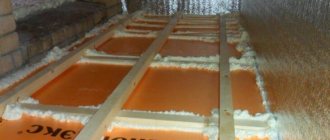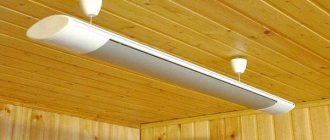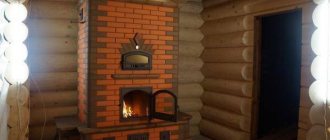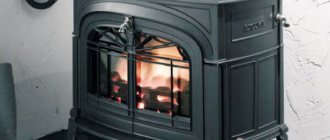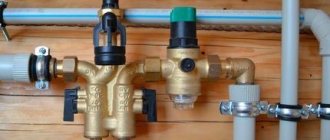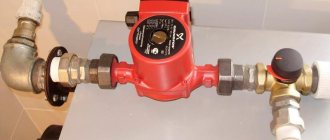Electric heaters of the new generation are economical and are one of the best options for heating a private home today. Let's look at what types of modern electric heating devices that economically consume electricity for residential premises exist, what are their differences and what are the main features, by what criteria should they be selected, and how to correctly calculate their power for specific application conditions.
Infrared heater in the house on the wall Source ali-top.ru
Varieties
In order to determine which heater is the most economical and efficient for a living space, it is necessary first of all to consider the main types of models existing today. Modern electric heaters are classified according to 2 main characteristics:
- Type - quartz, oil, ceramic, convector, thermal.
- Purpose - for the home, during frost, for drying clothes and linen, for the bath and shower, for shaping the style and interior.
Let's look at the features of each variety in more detail.
Type
A typical classification of household electric heating devices for heating comes down to the following list:
- Quartz.
The device is based on infrared radiation from a special quartz tube enclosed in a metal shell. The heat rays emanating from the device do not heat the air, but directly those surrounding objects and surfaces to which they are directed.
The quartz heater is based on a tube that emits heat Source alicdn.com
By design, quartz heaters are divided into standard tubular and film. The latter are based on a special membrane that emits in the infrared range. Thanks to this, it can be installed in the floor, walls and other surfaces. New generation quartz heaters are not only economical, but also highly efficient - their efficiency reaches up to 90%.
Pros:
- Operation in any type of room.
- Minimum power consumption.
- Quick heating of the room.
- Great working resource.
- Slight heating of the case.
- No unpleasant odors.
- Versatile installation - on the floor, wall, ceiling.
The disadvantages are associated with the impossibility of high-quality heating only through IR heaters. In addition, tube-type models are quite massive and large in size.
- Oily.
By type of design they are classified as radiators. The principle of operation is based on heating the coolant in the internal cavity of the device using a heating element. Thermal energy from it, in turn, is transferred to the metal body, and then to the surrounding air.
The mobile oil radiator can be easily moved and installed in the right place Source pechiexpert.ru
Most modern models are quite safe, as they are equipped with reliable thermostats that prevent overheating of the liquid and depressurization of the housing. Heaters are available in mobile and stationary versions.
Advantages:
- Easy installation.
- Easy to understand controls.
- Optimal cost.
- Long-term heat retention after shutdown.
- Automatic temperature control, which prevents excessive energy consumption.
Disadvantages manifest themselves in the form of strong heating of the case. Therefore, in order to prevent burns from accidental touch, the device will need to be equipped with an additional protective screen.
- Ceramic.
Externally, the device looks like a monolithic ceramic slab of certain dimensions. Thanks to the economical consumption of light, such new generation electric heaters have become widely used to equip country or country houses. The device design includes:
- Monolithic body.
- Steel box.
- Self-heating cable.
Ceramic heating panel with a heating cable inside Source maxikvarts.rf
See also: Catalog of companies that specialize in electrical work of any complexity
The device operates using two heating technologies at once - infrared radiation and convection. Therefore, it warms up the room very quickly and fully, which is important for the periodic use of a country house, especially in winter.
Pros:
- Versatility of use - for any room.
- Absolutely harmless to health.
- The average hourly electricity consumption is 350-400 W.
- Automatic settings, control and temperature control.
- Protection against overheating of the case.
- Minimal care and maintenance.
- Durability.
- Preservation of heat after shutdown.
Conditional disadvantages include installation restrictions. For full heat transfer, the device must be installed in an open place, but not in a niche or arches.
- Convector.
The device is based on natural or forced air circulation in a given direction. In essence, this is a radiator, through the lower part of which cooled air is taken in, and through the upper part the heated air flows out. The number of cycles is determined by the settings and depends on the set temperature.
Convector heater with rollers for moving around the room Source bani-nsk.ru
Pros:
- Light weight.
- Small dimensions.
- Low base cost.
- Efficient and fast heating.
The disadvantages are associated with the peculiarity of the device’s operation - mixing of air masses provokes the rise of dust and microorganisms. Therefore, for safe operation it will be necessary to install air purifiers.
- Heat fans.
This category of equipment is far from being the most economical electric heaters. This is primarily due to the principle of its operation. The device has a local effect - an air flow is passed through a hot spiral using a fan. Even for an average room, a model of sufficiently high power is required, which, with constant use, reduces all savings to nothing.
However, the device is ideal when you need to quickly heat a small room, for example, a room in a country house. Disadvantages include noise during operation.
Portable heat fan for heating a summer house Source ixbt.com
Which brand is the best economical heater to choose?
Before looking for a good model for personal requests and needs, the buyer should decide on the manufacturer. The market today is rich not only with global brands with considerable prices, but also with young, promising, noteworthy companies.
The best economical heaters in the ranking are represented by the following brands:
- Noirot is a French company founded in 1930, part of the international concern Muller. Numerous tests and competitions named Noirot No. 1 in the field of creating electric heating technologies. New innovative developments are constantly being introduced into production; the founder of the company was the first to install an electric thermostat in such devices.
- Ballu is a Russian brand that creates climate control devices using Italian and German technologies. The heaters are distinguished by their monolithic heating elements, which perform their direct tasks, but do not dry the air in the room. The latest models meet the main requirements - reliability, durability, and efficiency.
- Nobo is a Norwegian company that has been in business since 1918. In recent years, the demand for convectors with this name in Europe has increased sharply. More than 20 countries around the world are permanent markets.
- Resanta is a Latvian company that has been producing generators, voltage stabilizers, welding machines, and heaters for a long time at low prices. Each product unit is certified for compliance with international standards. In the Russian market in the budget segment, Resanta has remained a leader for several years in a row.
- Almac is a Russian manufacturer that creates inexpensive but high-quality heaters with German components. The main profile is infrared ceiling devices with a thin body, large heating area, and silent operation.
Criterias of choice
In order to accurately determine which heaters will be the most economical and efficient when used in the country or in your home, you need to take into account the following series of criteria:
- The area of the heated room. The characteristic is taken into account when determining the power of the device.
- The heating rate or the period of time during which the heater will heat the environment to a given temperature.
- Possibility of contact with a heated surface of the housing. Most often, children and animals suffer from burns from accidental contact with a heater. Therefore, if necessary, the device must be equipped with special protection.
- Cost including installation and connection.
Important! The most economical models of heating devices are those that are capable of automatically controlling a given heating level. With their help, the house will always be comfortable and warm, and at the same time they will not allow you to burn through a single extra kilowatt.
Video description
About electric heaters in this video:
When choosing the type of heating radiator, you must proceed from the specific conditions of its further use. Thus, energy-saving wall-mounted quartz heaters for the home, as well as fan heaters, are suitable for heating small areas. Ceramic, convection and oil are suitable for large and medium-sized rooms. If you need to create a full-fledged heating system, then it is better to select a combination of devices of various types - at the installation site.
Oil radiator for home Source dom-expert.by
Power calculation rules
In order for electric heaters for heating to effectively provide heat to homes, but at the same time maintain minimal energy consumption, it is necessary to correctly calculate their power. For this purpose, the following simplified formula is used: K = 0.277*C*pv*D*n*(T2-T1)
Where:
- C – specific heat capacity,
- pv – density of surrounding air,
- D – area of the heated room,
- n – ceiling height,
- T2-T1 – temperature difference between heated and cooled air.
With a very simplified calculation, for every 10 m² of housing area there should be 1 kW of heater power.
Note! There are special online calculators for the most accurate calculation of heater power. They take into account both basic and many additional parameters, which allows you to more accurately calculate the required heater power and prevent overpayment for excess power or, on the contrary, its lack.
How much does an oil heater consume per day?
This type of heater burns a small amount of oxygen and consumes little electricity. In addition, they are not as fire hazardous as other devices.
The disadvantages are high cost and heavy weight. On average, an oil heater consumes 750W per hour. More powerful heaters consume about 1 kW. But you can find devices with less power.
Since the device operates several hours a day, electricity consumption is significantly less.
Oil heater
The higher the power of the device, the more electricity it consumes. When the device is turned off and in rest mode, it does not waste energy. Despite some disadvantages, there are more advantages. That is why it is popular among residents of private houses. You can calculate the amount of electricity consumed after 1 month of using the device.
Briefly about the main thing
The correct choice of an economical heater is facilitated by knowledge of what types there are. Modern models are classified according to 2 main characteristics:
- By type – oil, quartz, ceramic, thermal fans and convectors.
- Intended use - for home, during cold weather, for drying clothes and linen, for shower and bath, for the interior.
Each variety has its own characteristics, advantages and disadvantages, and recommendations for use. When choosing a heater, it is necessary to take into account the area of the room, the required speed to reach the set temperature, the likelihood of a burn from the body, and cost. Before purchasing, you need to correctly calculate the power of the device.
Rating of the TOP 10 best energy-saving heaters for 2021-2022
| TOP 3 best energy-saving heaters by price/quality for 2021-2022 | ||
| 1 | Hyundai H-HV15-10-UI617 | Find out the price |
| 2 | Thermex Pronto 2000M | Find out the price |
| 3 | Timberk TFH T15NTX | Find out the price |
| TOP 3 best wall-mounted energy-saving heaters | ||
| 1 | Hyundai H-HV16-10-UI620 | Find out the price |
| 2 | Ballu BEC/EM-1000 | Find out the price |
| 3 | Nikaten NT 300 | Find out the price |
| TOP 2 best infrared-convective energy-saving heaters | ||
| 1 | Electrolux EIH/AG2-2000E | Find out the price |
| 2 | STN NEB-M-NSt 0.7 (mChk/mBq) | Find out the price |
| TOP 2 best infrared energy-saving heaters | ||
| 1 | Ballu BIH-AP4-0.8 | Find out the price |
| 2 | Ballu BIH-S2-0.6 | Find out the price |
Combined
The operation of such heaters is based on the principle of convection: the radiator contains oil, which is heated to the desired temperature, after which the metal body releases the resulting heat. The speed of heating the room is increased due to the built-in fan and turbocharging function, however, these features are not available in all models. Combined heaters are quite large and cumbersome, but they are cheaper than others.
On a note! An oil radiator is not suitable as the main heat source. This type of equipment is suitable for you if you are looking for an economical heater for your home for a short period when it is already cold and the central heating has not yet been turned on or has already been turned off.
Inverter air conditioners
Air conditioners operate on the principle of a heat pump and are fundamentally different from conventional heaters. The pump takes air from outside the room and moves it inside the room, and the air conditioner can operate even at sub-zero temperatures outside. The operation of an inverter heater is based on freon gas. It condenses and warms up in the heat exchanger of the indoor unit, after which it enters the outdoor unit. There, under low pressure, it becomes a gas again, boils and returns to the heat exchanger.
An inverter heater-air conditioner can warm up even a very large room in a short time.
Energy consumption when operating the air conditioner is 2-3 kW/hour. A room of 20 m² heats up in 3-4 hours.
Which one should you prefer for an apartment or a country house?
As a rule, city apartments have central heating, so the device will not be used constantly. The heater is turned on in the event of a failure of the central networks, to instantly raise the temperature in the room, as well as in the off-season.
The most economical electric heater for an apartment will be a convector. It consumes electricity moderately, does not require large investments when purchasing, and is capable of operating for a long time. It is worth refusing to buy a fan heater: this type of equipment makes noise during operation, and is the most energy-consuming type of heater.
If the central heating system operates with frequent interruptions, you should pay attention to infrared devices, which are often equipped with thermostats. Therefore, if you buy an electric heater with an electronic thermostat, this will significantly save energy resources, and therefore the family budget. Basically, such a heater requires more electricity, but fine tuning and various operating modes make it possible not to turn on the equipment at full power, while at the same time maintaining a comfortable temperature in the room.
Fine-tuning the infrared heater and various operating modes allow you to use the device as efficiently as possible, while at the same time saving energy resources.
Precision thermostat: NOBO Viking C4F10
Warmth for harsh Norwegian winters
The Norwegian heater manufacturer Nobo has been supplying its products to Russia since the early 2000s, so many have been using this equipment for 15-18 years. In the country of fjords and cold winters, they know well how to keep warm: the Nobo Viking CF410 heats the air with a power of 1 kW and does not waste a single watt - its energy efficiency is one hundred percent. In addition, according to European eco-standards, it is equipped with a high-precision thermostat, which does not allow the heater, after heating the air to the temperature you specify, to take more than 0.5 kW from the outlet. The thermostat is replaceable - if the built-in one seems ineffective to you, you can connect another one.
The heater is silent, fireproof, does not emit the smell of burning dust (unlike many convectors), works for up to 20 years under warranty and can be used in children's rooms. Disadvantages: price and rather strong drying of the air. If this fact is important to you, not long ago we wrote a review on how to choose a humidifier.
Ceramic panels
The operating principle of the ceramic panel is based on long-wave infrared radiation. The heating panel is enclosed in a steel box, characterized by high thermal conductivity and energy saving. Thanks to its neutral appearance, ceramic hobs will fit into any interior.
The energy consumption of a panel is directly proportional to its size. On average, it ranges from 0.2 to 2.5 kW/hour. To heat a room of 20 m², 1 kW/hour is required. It will take 1.5-2 hours to fully heat the room.
Micathermic heaters are a new product on the heating equipment market.

